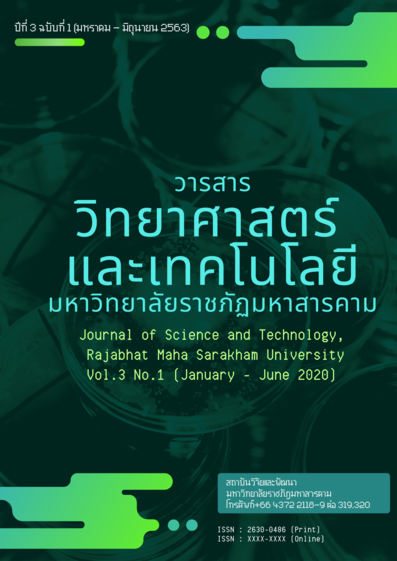Effect of Culture Condition on Oleaginous Yeasts Using Rice Noodle Wastewater
Keywords:
Biodiesel, Rice Noodle Wastewater, Oleaginous YeastAbstract
In Kalasin Province, the rice noodle making process uses large amounts of water with considerable wastage. Most organic compounds such as carbohydrates, starch and sugar, and proteins and nutrients such as nitrogen and phosphorus can be used as sources of carbon for microbial growth. Recently, biodiesel has attracted increasing attention as an important renewable power source to ameliorate the energy crisis and reduce global warming. Microbial oil can be used as an alternative raw material in biodiesel production instead of conventional oils. So, this study of culture conditions for microbial oils were determined using Candida tropicalis KS103 and Rhodotorula mucilaginosa BJMK43 in lipid accumulation medium for 8 days. Initial pH was set at 5.0 with incubation temperature of 30 oC. The nitrogen source was ammonium sulfate (NH4)2SO4 at 1.0 g/L. Results indicated that C. tropicalis KS103 gave optimal accumulation at 69.09±3.18% dry weight. Our results will contribute to knowledge concerning biodiesel development from oleaginous yeast.
References
กุสุมาวดี ฐานเจริญ, นิตยา นาฆะเมฆ และอัศนี แสนมา. (2561). “การผลิตไบโอดีเซลจากยีสต์สะสมไขมันสูงโดยใช้ไฮโดรไลเสทซังข้าวโพดเป็นแหล่งคาร์บอน”. วารสารเกษตรพระวรุณ. 15 (2): 345-354.
จิดาภา ทิน้อย และนวลศรี รักอริยธรรม. (2553). “การผลิตไบโอดีเซลจากจุลินทรีย์ที่คัดเลือก แล้วในอาหารที่เตรียมได้จากกากสับปะรด”. รายงานการวิจัย สถาบันพระจอมเกล้าคุณ ทหารลาดกระบัง: กรุงเทพฯ.
ชิษณุพงษ์ ประทุม. (2557). การบําบัดน้ำเสียโรงงานผลิตขนมจีนด้วยเชื้อจุลินทรีย์ที่มีประสิทธิภาพร่วมกับการบําบัดน้ำเสียแบบธรรมชาติ. กรุงเทพฯ: วิทยานิพนธ์ปริญญาปรัชญาดุษฎีบัณฑิต, มหาวิทยาลัยเกษตรศาสตร์.
นพวรรณ ด่านบำรุงตระกูล, ธีราพร ตังเจริญ และประมูล ภระกูลสุขสถิตย์. (2557). “ผลของยูเรียต่อการผลิตเอทานอลโดย Saccharomyces cerevisiae Sc90”. การประชุมวิชาการของมหาวิทยาลัยเกษตรศาสตร์ ครั้งที่ 52: 1-8.
รัตนภรณ์ ลีสิงห์. (2550). “เอกสารประกอบการสอน วิชา 317438 เชื้อเพลิงชีวภาพ”. ขอนแก่น: ภาควิชาจุลชีววิทยา คณะวิทยาศาสตร์ มหาวิทยาลัยขอนแก่น: ขอนแก่น.
วรพจน์ รัตนพันธุ์. (2550). “สภาวะการบําบัดน้ำเสียจากการผลิตเส้นขนมจีนโดยระบบแอนแอร์โรบิคคอนแทค”. กรุงเทพฯ: วิทยานิพนธ์ปริญญาวิศวกรรมศาสตรมหาบัณฑิตมหาวิทยาลัยเกษตรศาสตร์.
ศรีอุบล ทองประดิษฐ์ และสุภาษิต ชูกลิ่น. (2557). “การผลิตเอทานอลเชื้อเพลิงจากน้ำทิ้งโรงงานผลิตแป้งขนมจีน”. รายงานการวิจัย มหาวิทยาลัยเทคโนโลยีราชมงคลศรีวิชัย: สงขลา.
อภิเชษฐ์ ศรีวิชา และรัตนภรณ์ ลีสิงห์. (2553). “การผลิตลิปิดโดยยีสต์ไขมันสูงเพื่อใช้เป็นวัตถุดิบในการผลิตไบโอดีเซล”. The 11th Graduate Research Conference Khon Kaen University 2010, Khon Kaen, Thailand: 837-843.
อานนท์ ปะเสระกัง, วิโรจน์ ภัทรจินดา, คณิต วิชิตพันธุ์ และ รัตนภรณ์ ลีสิงห์. (2556). “ศึกษาผลของระดับกากน้ำตาลและแอมโมเนียมซัลเฟตต่อการผลิตไขมันในเซลล์ยีสต์ Trichosporon asahii”. แก่นเกษตร. 41 (ฉบับพิเศษ 1): 100-104.
Bligh E.G. & Dyer W.J. (1959). “A rapid method of total lipid extraction and purification”. Canadian Journal of Biochemistry and Physiology. 37 (8): 911-917.
Ma, S., Ye, L., Liu, C., Xia, N. & Deng, L. (2018). “Lipid engineering combined with systematic metabolic engineering of Saccharomyces cerevisiae for high-yield production of lycopene”. Metabolic Engineering. 52 (22): 134-142.
Miller, G. L. (1959). “Use of Dinitrosalicylic Acid Reagent for Determination of Reducing Sugar”. Analytical Chemistry. 31 (3): 426–428.
Perrier, V., Dubreucq, E., Galzy & Arch, P. (1995). “Fatty acid and Carotenoid composition of Rhodotorula strains”. Archives of Microbiology. 164 (3): 173-179.
Puangbut, M., Rattanachan S., Paine, T. & Leesing, R. (2016). “Conversion of Fermented Rice Noodle Wastewater to Microbial Lipid by Mixed Culture of Microsoft and Yeast”. Journal of Clean Energy Technologies. 4 (4): 257-261.
Ratledge, C. (2004). “Fatty acid biosynthesis in microorganisms being used for Single Cell Oil production”. Biochimie. 86(11): 807–815.
Siripattanakul, S., Ratanapongleka, K., Sangthean, P., Yoottachana, K. & Pimwongnok, K. (2010). “Fermented rice noodle wastewater treatment and ethanol production potential using entrapped yeast cells”. Water Practice & Technology. 5: 1-8.
Siripattanakul-Ratpukdi, S. (2012). “Ethanol production potential from fermented rice noodle wastewater treatment using entrapped yeast cell sequencing batch reactor”. Applied Water Science. 2: 47-53.
Xu P., Li L., Zhang F., Stephanopoulos G. & Koffas M. (2014). “Improving fatty acids production by engineering dynamic pathway regulation and metabolic control”. Proceedings of the National Academy of Sciences.111: 11299–11304.



